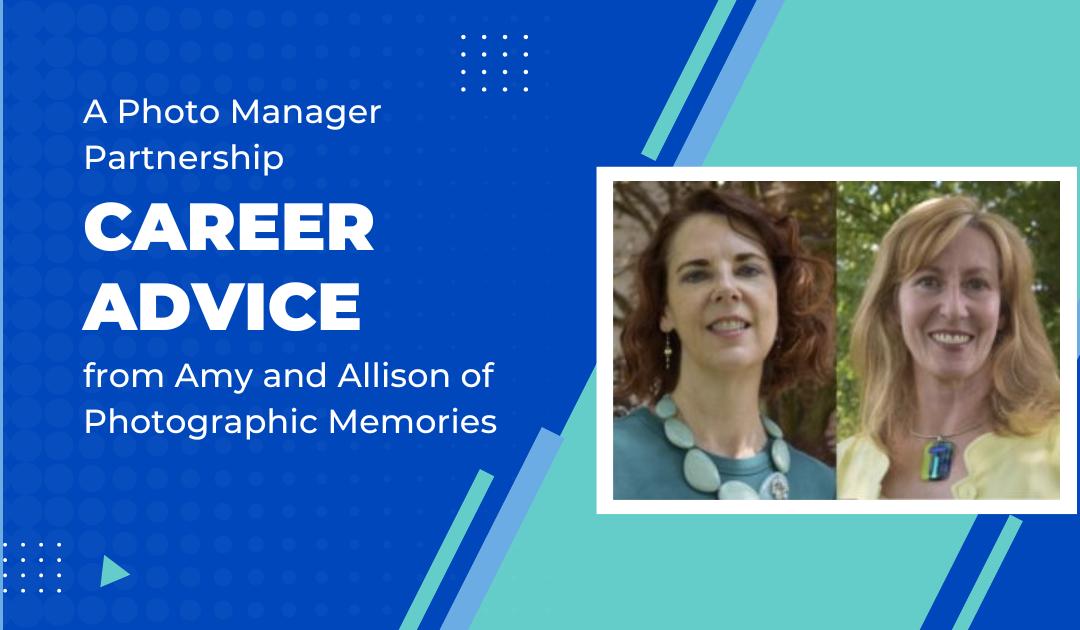 In this unique “Career Advice from a Pro” interview, we are talking to business partners, Amy Secor and Allison Pihl of Photographic Memories. Let’s learn how a Photo Manager partnership works!
In this unique “Career Advice from a Pro” interview, we are talking to business partners, Amy Secor and Allison Pihl of Photographic Memories. Let’s learn how a Photo Manager partnership works!
These business partners came from very different backgrounds but have come together to make a great team. Before becoming a photo manager, Allison owned a move management company based in Maryland for 15 years. While helping her clients transition between homes, Allison often noticed that photos were one of the common items that got stuck in storage after a move.
Amy, the other half of this dynamic duo, started out first as a graphic designer and then applied her design skills to department stores. Her job consisted of laying out the stores, dressing mannequins, and creating the customer experience throughout the building. As a hobby, Amy decided to start digitally restoring old family photographs for family and friends, including her sister-in-law Allison.
Then, the pandemic happened and the world changed…
How did you become business partners?
We call the business our pandemic baby. We were both looking to make some kind of change in our careers. I had sold my business and was looking to do something different. Photo organizing just made sense!
One of the key things to being in a successful partnership is deciding that the relationship between the partners takes priority over the business. That means there’s a lot of discussion about priorities, goals, and reevaluating to ensure things are still a good fit for both parties. These discussions happen both before you start the partnership and then you need to keep checking in along the way.
It’s also important to recognize that it’s not about ego. One person will be better at taking care of certain aspects of the business. In our partnership, there are circumstances where it’s not even a question of who’s going to handle certain things because we know who’s strength it fits into.
How did your experience as a move manager impact you as a photo manager?
When you are working with somebody who’s downsizing and has a deadline to move into their apartment, they don’t have time to sit and go through their photos. We all know how long that can take, particularly when it’s the person who owns the photos during it rather than a photo manager. So those photos would go into boxes and go into storage somewhere, or they get shipped to a kid, or sometimes people just walked away because it was overwhelming. Based on that, it’s clear that the move management industry and the senior living communities are a tremendous marketplace for photo managers because there is a real gap there.
What services do you provide and who is your ideal client?
Our services begin with both digital and physical organizing. To do this, we always tell clients that we’re going to begin at the end. Our first step is to ask them what their end goal is because that influences how we approach the project. We digitize, scan, and then set up a family website, put together photo books, create gallery walls, and other ways to showcase their collection.
Our first client shipped us boxes that contained her mother’s collection. It had photos, both recent and old, plus letters, magazine articles, old documents, tapes, and more. It really had everything. This pushed us into figuring out how we were going to offer all these services, including who we could partner with for jobs we couldn’t do in-house.
Tell us about how you got started as photo managers.
We really did just jump in with both feet, even though we know we would totally mess something up. A big piece of the courage to get started was the community and training provided by The Photo Managers.
We started by sitting down to figure out who our target market was, how we would find them, and how we would reach them. We also calculated what we would need in terms of startup costs. As we do with our clients, we started with our end goal. Once we knew what kind of business we wanted, we were able to find out what we would need to support that.
Our first investments included Dubsado, which is the platform we use to manage our client information, as well as our training and our website. A former colleague was starting out as a social media manager, so we brought her in as well.
During our training, one of the biggest learnings for us was how to estimate the time involved in a job. We now know that just because an envelope says “1986 Trip to Florida”, doesn’t mean that’s actually what’s in there. There have been some estimates that we absolutely missed the mark on. Now, we are keeping track of how much time we spend on each client so we can look back at how close it was to the initial estimate. We are also aware of the need to charge for the value we provide to our clients.
How do you find new clients?
The first couple of clients are usually people you know. We also did a presentation for my [Amy’s] book club. This was a chance to polish our speech and get our feet wet by presenting to a friendly audience. We were expecting 10 or 15 people, but 50 showed up. We had planned to spend about 30 minutes talking about photo organizing tips, who we are, and what we do, followed by 15 minutes for questions. Two hours later we were finally getting things wrapped up and it was obvious the need was real.
When you can get in front of a small group in your community, that’s a tremendous place to gather referrals to get some business. I really believe that we just need to be talking about our businesses constantly. If you’re talking about it, somebody’s either going to need it themselves, or they’re going to know somebody else who does.
Our next events will be Lunch-and-Learn sessions at some seniors communities. We’ve also done webinars with move managers to teach their teams about photo organizing. Many organizations need education at their events, so offering to speak is a great way to get the word out about your business.
The other way that we get referrals is through professional organizers, downsizers, and move managers. Often these are connections from my previous business. One of our best referral sources is my favorite mover who I worked with for 15 years. He’s in people’s homes all the time and, when he sees a photo collection, he gives out our cards. We have really found that referrals, and working your network, are how the business is coming to us.
What do you love about being a Photo Manager? And, what do you not love about it?
We love our clients and hearing their stories. It’s fascinating to look at the old black-and-white photos from the early 1900s – the old house, the old car, the kids dressed up for Easter. It’s so much fun to meet our clients and understand what it means to their families to have their photo collections organized.
When it comes to things we don’t love, spending an entire day just scanning photos can be difficult. Also, it can be a challenge to cut yourself off from work. When you find yourself lying awake at night with someone’s photos running through your head, you know it’s time to take a break.
How has membership in The Photo managers helped your business?
The training has been a lifesaver and we also appreciate having the community there. If we ever run into a problem where something is not working, we can post about it in the member’s Facebook group and 10 to 15 minutes later, someone is jumping in to help us solve the problem.
The Photo Managers is a supportive environment, not a competitive association. There are so many potential clients out there that there is no need to be competitive or keep secrets. The training courses and the annual conference have also been wonderful. The guidance we received there really allowed us to jumpstart our business much faster than we would have if we were trying to figure this out on our own.
Watch the full interview with Amy and Allison below as they answer additional questions on their business partnership, equipment, clients, and more.
Key Takeaways:
#1: You don’t have to go it alone! A strategic photo manager partnership can bring even more strengths to a business.
#2: Get the word out about your services by offering to speak at local events.
#3: Work with local referral partners such as move managers to help connect you with potential clients.


Recent Comments